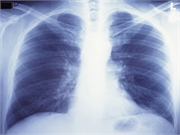MONDAY, Jan. 27, 2020 (HealthDay News) — Combining an imaging technology with a new drug that “lights up” lung cancer cells may help surgeons spot hidden bits of cancer, a new study suggests.
The small, preliminary study found that the new combo — dubbed intraoperative molecular imaging (IMI) — helped improve outcomes in surgeries of 1 out of 4 patients.
The drug used in IMI is called OTL38. The drug isn’t yet approved by the U.S. Food and Drug Administration. OTL38 is made up of a dye that can be seen by near infrared light and a targeting molecule. The molecule targets receptors on cancer cells, making them visible with near infrared light.
That’s important because lung cancer can come back after surgery if any areas of cancer are missed. Past studies have shown that cancer comes back after surgery for as many as 30% to 55% of people with a type of cancer called non-small cell lung cancer, the researchers said.
The findings were to be presented Monday at the Society of Thoracic Surgeons’ annual meeting, in New Orleans.
“Near-infrared imaging with OTL38 may be a powerful tool to help surgeons significantly improve the quality of lung cancer surgery,” study author Dr. Inderpal Sarkaria said in a meeting news release. Sarkaria is a thoracic surgeon from the University of Pittsburgh Medical Center.
The study included 92 people from six different hospitals being treated for non-small cell lung cancers. They were all scheduled for surgeries to remove the areas of suspected cancer.
All 92 patients were given OTL38 intravenously. Lung cancer surgeries are done in three parts, according to the researchers. These include inspection, resection and specimen check.
After removing areas identified by imaging before surgery, the surgeons looked for cancers that might have been missed — inspection. They do this during surgery with a visual inspection and manual touch of the area.
Surgeons were able to find two patients who had additional suspicious lesions during the inspection phase. The molecular imaging technology found 10 additional cancers in seven patients.
During the resection, or tumor removal phase, the researchers found the new technology located lesions that weren’t found in 11 patients. And, during the specimen check phase, the molecular imaging found microscopic areas of tumor left at the edges in eight patients.
Overall, the molecular imaging technique and drug may have improved surgical outcomes for 26% of the lung cancer patients.
Dr. Brendon Stiles, a thoracic surgeon at New York-Presbyterian Hospital in New York City, wasn’t involved in the study, but reviewed the findings.
He said the potential for the new technology is “exciting” for certain types of early lung cancer lesions that aren’t easy to see or feel.
“There really shouldn’t be any side effects; it’s fast and user-friendly,” Stiles said.
But he added that the technology may be somewhat limited because near infrared light doesn’t see deeply into the body.
“Pre-op imaging has gotten so amazingly good, we’re finding earlier and earlier cancers. It’s hard to think they’d find nodules that weren’t on the CT scan,” Stiles said.
Lead study author Dr. Sunil Singhal, from the Hospital of the University of Pennsylvania, said the research team will begin a multi-site randomized clinical trial of the drug and imaging combination this spring.
Findings presented at meetings are typically viewed as preliminary until they’ve been published in a peer-reviewed journal.
More information
Learn more about lung cancer and types of imaging tests from the Radiological Society of North America.
Copyright © 2025 HealthDay. All rights reserved.

